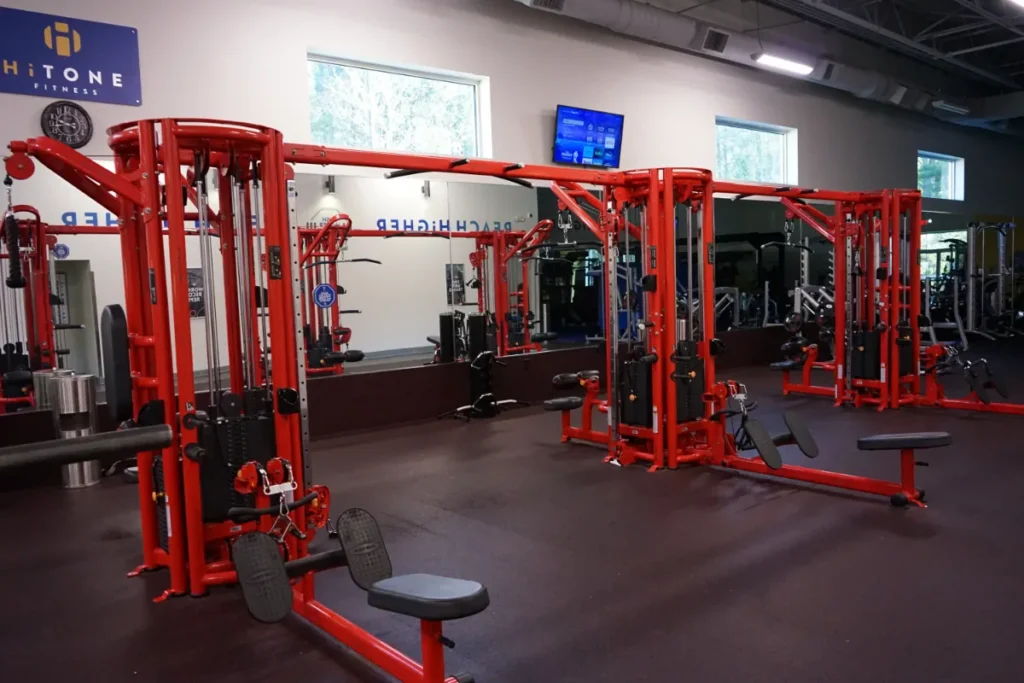Let’s face it: losing weight and getting fit is hard. There’s so much information nowadays, from what to eat to what to do, that we often feel overwhelmed and quit even before we start. Luckily for us, we don’t have to know it all. The only thing we have to do is choose someone to guide us towards all our goals. That can be a personal trainer in your one-on-one classes or a trainer at group fitness programs. If you’re just starting your gym journey and unsure where to begin, this guide is for you. Use it as a compass to navigate the world of group fitness programs vs personal trainers. Its purpose is to give clarity on achieving fitness goals for beginners.
Exploring Small Group Fitness Programs
The popularity of group fitness programs has skyrocketed in the past few years.
From different types of workouts that combine dance and exercise like Zumba and Spin classes, Pilates and Aqua aerobics, to Yoga and Body Pump, there are options for everyone.
They usually have around 20 participants in one group to ensure everyone has enough space and gets equal attention from a trainer.
But what are the pros of working out with others?
The Benefits Of Small Group Fitness Classes
Community
One of the key benefits of small group fitness is the sense of community.
You work out alongside like-minded individuals who share similar goals and face similar problems. This creates a supportive environment, where you can be motivated by others’ determination and commitment. Research shows that being a part of a fitness group helps individuals overcome challenges and stressors.
There is another benefit of being part of a community: a sense of belonging.
According to the American Psychology Association, an estimated 44 million American adults feel alone, especially those living in big cities. Group workouts become a place where you can meet new friends and expand your social circle while burning calories and working on your fitness goals.
Plus, knowing that someone’s expecting to see you often leads to increased accountability. People who have social support from the group are more likely to stick to their fitness routines because of the sense of responsibility to the group.
Variety
Variety is another advantage of small-group fitness classes.
Classes like Zumba, Body Pump, etc., often use different movements and equipment, preventing monotony and keeping everyone engaged. A single class usually has different elements of cardiovascular training, strength conditioning, and flexibility exercises, providing a well-rounded and comprehensive workout.
This means you won’t get easily bored or hit the plateau before you reach your goal.
Cost
Small group fitness classes are generally more affordable than one-on-one personal training sessions.
This makes them an attractive option for everyone seeking professional guidance without spending a lot of money.
Cons Of Small Group Fitness Classes
However, it’s important to acknowledge the cons of small-group fitness as well.
Lack of personalized attention
One potential downside is the lack of personalized attention. If a group is larger than 20 members, it could be difficult for the instructor to provide individualized feedback and correct everyone if needed.
Participants with specific needs, injuries, or concerns might find it challenging to receive the focused attention required to address their unique circumstances. This may lead to demotivation, prevent progress, or even lead to improper form.
Different abilities
Sometimes, small group classes often have members with different abilities or fitness backgrounds. While some may be beginners, others might be more advanced. This discrepancy in fitness levels can pose a challenge for instructors to tailor the intensity of the workout to suit everyone, potentially leaving some participants feeling either overwhelmed or under-challenged.
Working Out With A Personal Trainer
How many times have you thought, “If only I had someone to guide me step by step and help me avoid mistakes?”
This is exactly what you get when working with a personal trainer.
They are certified fitness professionals dedicated to tailoring workouts to your specific needs. According to research, one-on-one personal training is an effective method for changing attitudes toward fitness, resulting in increasing the amount of physical activity.
Another research shows that members whose training is directed by well-qualified personal trainers achieve significantly greater improvements in lean body mass and other dimensions of fitness than members who direct their own training.
This alone is a significant benefit of working out with a personal trainer, but it’s not the only one.
Benefits of Working with a Personal Trainer
Personalized approach
One of the biggest benefits of individualized training is the personalized approach.
Your personal trainer knows your goals, fitness level, health concerns, and different objections, which helps a trainer tailor each session to address your specific needs. This level of customization ensures you receive a program designed to match your abilities and gradually progress as your strength and endurance improve.
Another important benefit of a personalized approach is real-time feedback.
It allows you to have proper form and reduces the risk of injury. If you’re a beginner or unfamiliar with different gym equipment, a personal trainer will be there to guide you every step of the way.
Knowledge and experience
Having a professional fitness trainer with years of experience means you’ll have answers to all of your questions.
They will use their knowledge and experience to help you navigate the unfamiliar territory of gym equipment and exercises, explaining the purpose and benefits of each exercise.
This is particularly crucial for beginners who may not have a clear understanding of which exercises align with their goals or how to structure a well-rounded fitness routine.
Motivation and accountability
It’s easy to skip going to the gym when nobody expects to see you there.
But working out with a personal trainer means you can’t make excuses, which helps you be consistent and stay on track.
Your personal trainer is both your mentor and accountability partner, setting realistic goals, monitoring progress, and providing constructive feedback.
Plus, the ongoing encouragement and support you get from your trainer can be a powerful motivator. Personal trainers know how to motivate, educate, and support you through different challenges.
Time efficient
Nowadays nobody has time for ineffective workouts or spending hours in the gym.
Having a personal trainer by your side means you efficiently use your time during workouts.
With undivided attention, your fitness trainer can create focused, goal-oriented sessions, optimizing each minute for maximum results.
This time efficiency is especially beneficial for anyone with a busy schedule who wants to maximize the effectiveness of their workouts without spending unnecessary hours in the gym.
Nutritional advice
To get fit it’s not enough to workout regularly. We also need to eat healthy, nutritionally rich food.
People often struggle with what food to eat before their workout to get that boost of energy, or what to eat after the workout to help the muscles grow.
With guidance from your personal trainer, you’ll know what to eat and when. They can create a personalized meal plan based on your goals, taking into account factors such as weight loss, muscle gain, or overall well-being.
Personal trainers, as educators, can demystify nutritional concepts, helping you make informed choices about portion sizes, macronutrient ratios, and food selection. This education empowers you to develop a sustainable and healthy relationship with food.
Cons Of Having A Personal Trainer
However, it’s essential to consider the potential downsides of one-on-one training.
Cost
Cost is a significant factor, as personalized sessions with a fitness trainer can be more expensive than group classes or independent gym workouts.
For beginners on a budget, the investment in a personal trainer may require careful consideration and financial planning.
Lack of social component
While one-on-one training provides an intimate setting for personal growth, some people miss the opportunity to meet other people and share the experience of reaching their fitness goals
This may impact the overall enjoyment of the workout, especially for those who thrive in a more social environment.
Personal trainers are not your thing? Check out how to get started the top men’s fitness classes.
How To Decide Between Group Fitness Or Personal Training?
Small fitness groups and the one-on-one approach have both their pros and cons.
To make the right decision for yourself, it’s crucial to understand your goals.
Do you want to burn calories in a fun way while enjoying the support of your group, or do you want to have the undivided attention from your trainer?
If you thrive in a community setting, crave variety, and enjoy a social workout, group fitness is your arena. If you’re seeking a one-on-one experience, personalized attention, and a specific focus, a personal trainer is your fitness ally.
Whatever option you choose, one thing is sure: you’ll be one step closer to crushing your fitness goals. At HiTone Fitness, you’ll find everything you need and more: from various group workouts to experienced personal trainers.





